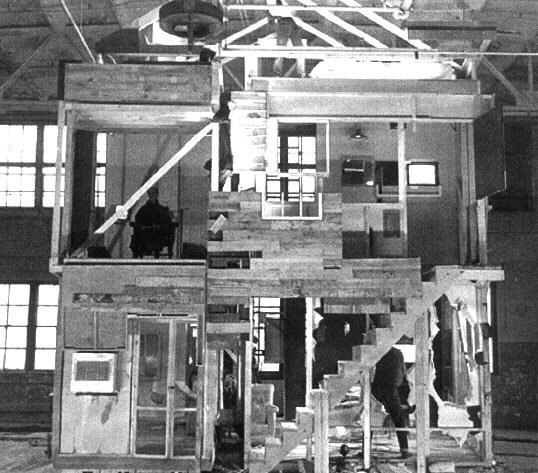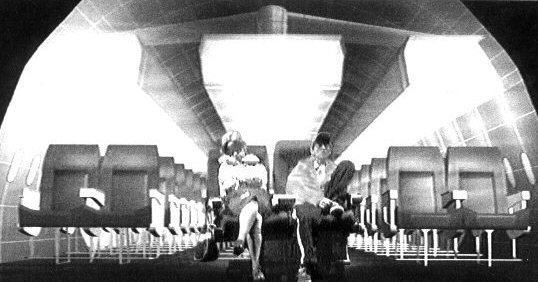Please wait a few moments while we process your request

The Builders Association
(New York, N.Y., United States)
Founded by Marianne Weems in 1993, The Builders Association produces multidisciplinary performances that combine new media with the performing arts. For these projects, Weems, the troupe's manager and stage director, surrounds herself with a great many collaborators, including architect Don Cleater and video maker Peter Norman. Since 1994, the group has presented six productions uniting formal innovation and social criticism.
The approach of The Builders Association lies at the crossroads of visual arts, architecture and performance. Master Builder (1994), staged in an abandoned industrial space in the Chelsea area of New York, investigates different representations of domestic space. The actors move about in a three-storey model house fitted with sensors that are connected to MIDI protocol and trigger audio and video segments. The project is meant as both a performance and an installation: the audience can explore the interior of the house, activate the sensors and take in the theatrical performance.
In Imperial Motel (Faust) (1996) and Jump Cut (Faust) (1997), Marianne Weems compiles the many re-readings generated by the myth of Faust, producing a remarkable synthesis of elements from several eras. (1) She examines Murnau's Faust, among others, and puts together a modern version of the story set in a motel room. The White Album (1995), which stems from a collaboration between the students at New York University's Experimental Theater Wing (New York, New York, U.S.) and The Builders Association, plays on the simultaneity of two arbitrarily linked events, presenting side by side a rock group rehearsal and a post-synchronization session in a television studio.
Developed with architects Elisabeth Diller and Ricardo Scofidio, Jet Lag (1998) is inspired by two news items reported by the media in the 1960s. The stories serve as fables about modern travel and the loss of spatio-temporal reference points. A yachtsman creates the illusion that he is sailing around the world when he is actually sailing in circles on the Atlantic. A grandmother and her grandson make 167 consecutive roundtrips between New York and Amsterdam. The navigator is slowly driven mad by his sensory difficulty, while the grandmother finally succumbs to the effects of jet lag. The technological devices used on stage (computer-generated images, closed-circuit video) support the actors' performances and help shape the artificial environments surrounding them. These devices are also brought into play to counter the fascination that they exert in the media. Presented in Europe and North America, Jet Lag was unanimously acclaimed by critics, as much for its technical achievements as for the issues it raises.
In Xtravaganza, first performed in 2000 at the Pulse festival of the Whitney Museum of American Art (New York, N.Y., United States), The Builders Association takes its inspiration from the musicals produced between 1910 and 1930. By reviving forms of entertainment from the early part of the last century, Marianne Weems sets out to establish a genealogy of these lavish productions that incorporated film, theatre and dance. She tells the story of four great figures of the entertainment industry: Stele MacKaye, Loie Fuller, Florenz Ziegfeld and the legendary Busby Berkeley. Xtravaganza again brings together live and recorded segments, as excerpts from vintage films are combined with video material shot on stage. Peter Norman, video designer and long-time collaborator, uses the NATO system, which simultaneously transmits live images and archive material saved on a computer hard disk.
In 2001 and 2002, The Builders Association has joined forces with the London collective motiroti to create a multidisciplinary project that re-examines the many versions (traditional and modern) of the legend of Aladdin.
The approach of The Builders Association lies at the crossroads of visual arts, architecture and performance. Master Builder (1994), staged in an abandoned industrial space in the Chelsea area of New York, investigates different representations of domestic space. The actors move about in a three-storey model house fitted with sensors that are connected to MIDI protocol and trigger audio and video segments. The project is meant as both a performance and an installation: the audience can explore the interior of the house, activate the sensors and take in the theatrical performance.
In Imperial Motel (Faust) (1996) and Jump Cut (Faust) (1997), Marianne Weems compiles the many re-readings generated by the myth of Faust, producing a remarkable synthesis of elements from several eras. (1) She examines Murnau's Faust, among others, and puts together a modern version of the story set in a motel room. The White Album (1995), which stems from a collaboration between the students at New York University's Experimental Theater Wing (New York, New York, U.S.) and The Builders Association, plays on the simultaneity of two arbitrarily linked events, presenting side by side a rock group rehearsal and a post-synchronization session in a television studio.
Developed with architects Elisabeth Diller and Ricardo Scofidio, Jet Lag (1998) is inspired by two news items reported by the media in the 1960s. The stories serve as fables about modern travel and the loss of spatio-temporal reference points. A yachtsman creates the illusion that he is sailing around the world when he is actually sailing in circles on the Atlantic. A grandmother and her grandson make 167 consecutive roundtrips between New York and Amsterdam. The navigator is slowly driven mad by his sensory difficulty, while the grandmother finally succumbs to the effects of jet lag. The technological devices used on stage (computer-generated images, closed-circuit video) support the actors' performances and help shape the artificial environments surrounding them. These devices are also brought into play to counter the fascination that they exert in the media. Presented in Europe and North America, Jet Lag was unanimously acclaimed by critics, as much for its technical achievements as for the issues it raises.
In Xtravaganza, first performed in 2000 at the Pulse festival of the Whitney Museum of American Art (New York, N.Y., United States), The Builders Association takes its inspiration from the musicals produced between 1910 and 1930. By reviving forms of entertainment from the early part of the last century, Marianne Weems sets out to establish a genealogy of these lavish productions that incorporated film, theatre and dance. She tells the story of four great figures of the entertainment industry: Stele MacKaye, Loie Fuller, Florenz Ziegfeld and the legendary Busby Berkeley. Xtravaganza again brings together live and recorded segments, as excerpts from vintage films are combined with video material shot on stage. Peter Norman, video designer and long-time collaborator, uses the NATO system, which simultaneously transmits live images and archive material saved on a computer hard disk.
In 2001 and 2002, The Builders Association has joined forces with the London collective motiroti to create a multidisciplinary project that re-examines the many versions (traditional and modern) of the legend of Aladdin.
Vincent Bonin © 2001 FDL
(1) "Jump Cut (Faust)," The Village Voice, (Dec.16, 1997).
Related page:
 motiroti and The Builders Association, Alladeen
motiroti and The Builders Association, AlladeenThis project re-examines the legend of Aladdin in light of its original Hindu and Muslim versions, as well as its film adaptations produced by British, American and Indian studios.
External link:
The Builders Association :
http://www.thebuildersassociation.org/
http://www.thebuildersassociation.org/









